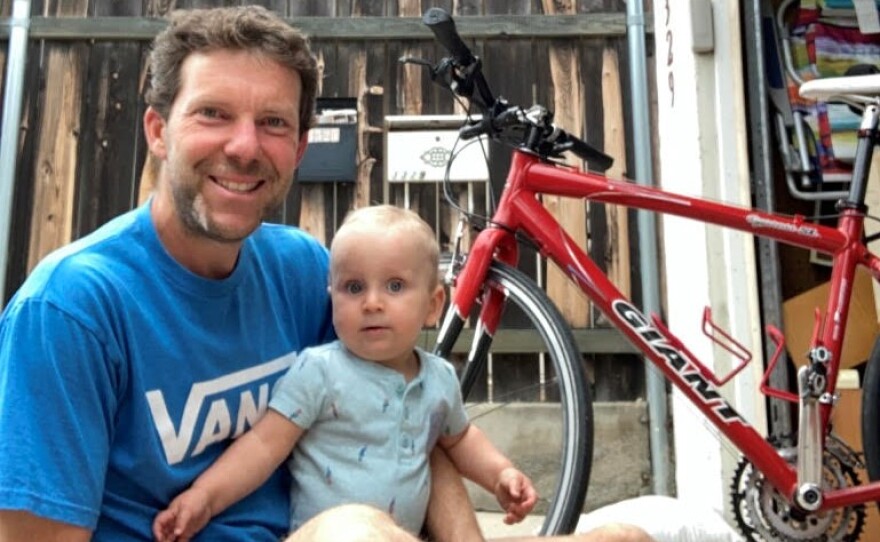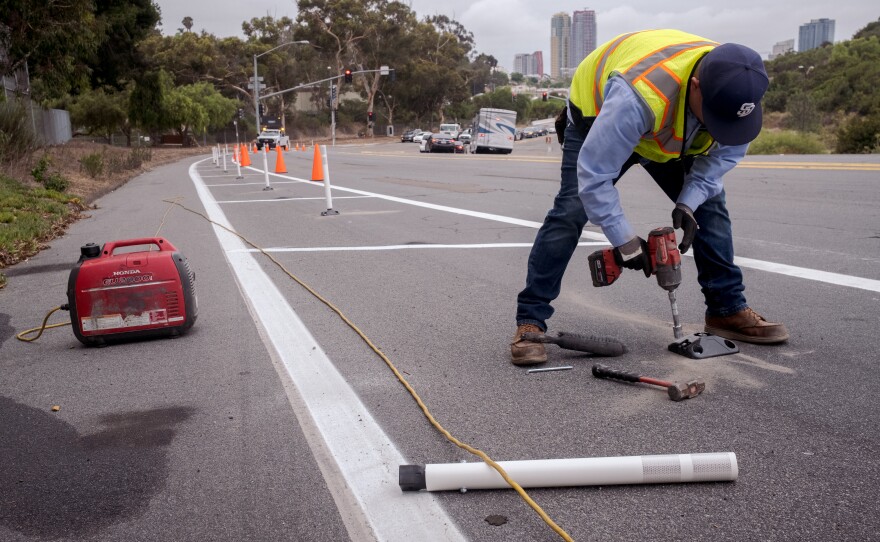Laura Keenan sits in her living room next to her 1-year-old son, Evan, and reads one of his favorite books. Evan's big blue eyes dart between the book and our video camera. The amusement and curiosity in his smile belie a horrific tragedy that struck this family two weeks ago.
On Sept. 14, Evan's father, Matt Keenan, was riding his bike on Camino del Rio South in Mission Valley. A driver going the opposite direction crossed the road's double yellow lines and struck Matt head on. Neither Matt's helmet, nor his lights, nor the narrow painted bike lane could save him. The collision killed him almost instantly.
"He was just so excited to see Evan grow up," Laura Keenan said through tears. "(Evan) was going to take his first steps soon, and Matt wanted to teach him music and play sports with him. And he's never going to be able to do that."
Evan will grow up not knowing his father, Keenan said, but she will do her best to keep her husband's memory alive. He was funny, kind, charismatic and a caretaker, she said. And he loved biking.
"He'd ride to work ... from North Park to La Jolla, he would ride his bike to go to the grocery store or just run different errands," Keenan said. "If a day went by without biking, it was not a complete day for him."
RELATED: Surge In Cyclist Deaths Prompts Calls For Faster Safety Upgrades
Keenan is convinced if the bike lane on Camino del Rio South had some kind of physical barrier — say a concrete curb or plastic posts — her husband would still be alive today.
But San Diego has no plans to improve the bike lanes on Camino del Rio South. The city's 2013 Bicycle Master Plan calls for no changes to the road. The Mission Valley Community Plan, updated in 2019, calls for extending painted bike lanes along the entirety of Camino del Rio South, but not improving the bike lanes with protective barriers.
Elizabeth Mayer, program manager for the nonprofit BikeSD, said Matt Keenan's death shows the city's existing and planned bike infrastructure is inadequate and that the Bicycle Master Plan needs an update.
"Paint is not protection," Mayer said. "And I think that in order to meet the goals that they set both for climate and for Vision Zero, there needs to be swift change."

Vision Zero is the city's campaign to end all traffic deaths and serious injuries by 2025. San Diego's Climate Action Plan also calls for the city to triple the share of bike commuters to lower greenhouse gas emissions. The city is far behind on both goals.
Mayor Todd Gloria has said he's speeding up the process of adding new bike lanes and improving existing ones with more protection. His current budget includes funding for 12 new staff positions that he says will design and implement nine miles of bike lanes per year.
And last week, Gloria announced Pershing Drive in Balboa Park would have new protected bike lanes by early next month. That came after two people — a cyclist and a scooter rider — were killed by drivers this summer.
RELATED: Cyclists, Business Owners Review New 30th Street Bike Lanes In North Park
"I brought to this office a firm commitment to creating safe and easily accessible ways for San Diegans to get from Point A to Point B without a car,” Gloria said in a statement. "Traveling around our city without a car should not be life-threatening. I will continue to work to make active transportation safe for all residents in all neighborhoods.”
The decision to upgrade the bike lanes on Pershing Drive demonstrates the broad power Gloria has over city operations and street design, said Jordan More, fiscal and policy analyst with the city's Independent Budget Analyst's Office. Gloria can order city workers to create new bike lanes pretty much anywhere if he decides they're more urgent than other projects in the pipeline.
"The mayor can, to a certain extent, redirect staff to different priorities," More said. "The question would be … where would you find (the money) and what would those tradeoffs have to be? Because it really is a question of tradeoffs and service level impacts if you don't have new revenue."
In other words, bike lanes must compete with all the city's other infrastructure needs such as filling potholes and repairing broken sidewalks.

RELATED: Coronavirus Means Big Business For San Diego Bicycle Shop
Beyond the financial challenge, bike lanes in San Diego can also be controversial, particularly when they require removing parking or a lane of travel for cars.
But despite the political headwinds, bike lanes are much easier to implement now than just a few years ago. A 2020 state law exempts most bike lanes from the California Environmental Quality Act, which bike lane opponents have used to block, delay or water down bike safety projects. The law, which will sunset in 2023 if not extended, has not yet been used in San Diego to build any new bike lanes.
Laura Keenan, now a single mother, said she was encouraged by the mayor's action on Pershing Drive. And she said she hopes the opponents of bike lanes keep their concerns over parking and traffic flow in perspective.
"If you were able to put this bike lane there, maybe another wife and another son would have their husband and dad one day," Keenan said. "Because it can save a life. And I would do anything to take this pain away from anybody else, because it's just the worst experience. Worse than I could ever imagine."








